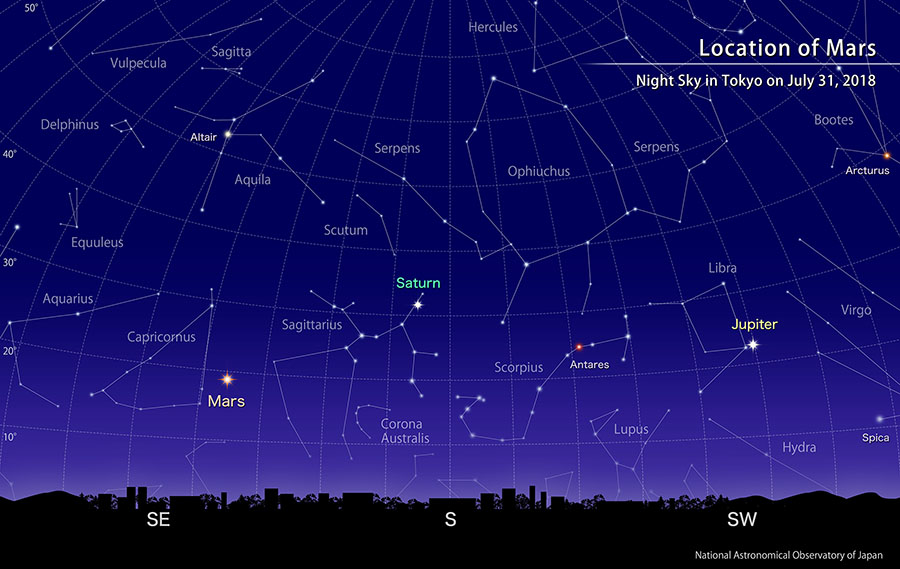Mars Makes its Closest Approach to Earth (July, 2018)

Look for Mars in July 2018
Mars makes its closest approach to Earth on July 31. At closest approach, the distance between Earth and Mars is 57.59 million kilometers. The current closest approach is one of the “best” closest approaches. At 4:50 p.m. on July 31, the Earth and Mars approach at a distance of 57.59 million kilometers. At this time, the apparent diameter of Mars exceeds 24 arcseconds (about 1/77th of the Moon’s apparent diameter). Its magnitude becomes - 2.8, making it brighter than Jupiter.
In 2003, the Earth and Mars approached within 55.76 million kilometers and received much attention. This is the first time since 2003 that Mars approaches closer than 60 million kilometers.
Mars is the next planet from the Sun after Earth, so it passes the Earth (conjunction), over and over in a cycle of approximately 780 days (roughly 2 years and 2 months). Earth’s orbit is very close to a circle in shape, but Mars’s orbit has a little bit of a squeezed oval shape. Also, because the synodic period (time between conjunctions) is not exactly 2 years, but instead 2 years and 2 months, the place where Earth and Mars pass shifts each time, and the distance at closest approach varies drastically. (The distance during the longest approach is almost twice the distance during the shortest approach.)
The diameter of Mars is small, about half the size of the Earth. When Mars is far away, you cannot observe its surface, but when it makes its closest approach to the Earth, Mars looks bigger. This will be a great opportunity to observe Mars this year.
The day when Mars is the nearest, called closest approach, gets the most attention. But the distance between Earth and Mars doesn’t change much for several weeks before and after closest approach. Please take this opportunity to observe Mars with a telescope. People who don’t have a telescope can visit a public observatory to see Mars with a large telescope.
Where can we see Mars in the night sky?

On July 31, Mars is located in the constellation Capricornus. Seen from Tokyo, Mars rises in the southeastern sky around 7 p.m. and reaches culmination around midnight. Its brightness is -2.8 magnitude. Also, the Moon rises in the eastern sky around 9:00 p.m. The bright red Mars shines against the moonlight and its reddish color and brightness stand out in the night sky.
Reference: Ephemeris Computation Office
With the “Sky Viewer” you can easily explore the appearance of a typical urban night sky (planets and constellations are visible). The Celestial Phenomena section of the glossary explains the planetary phenomena terms: greatest elongation, opposition, conjunction, stationary, etc.